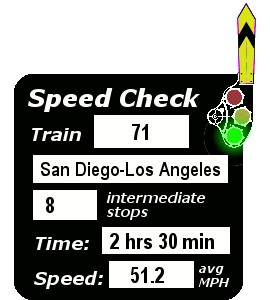



Time:
A - A.M.
D - Train stops only to discharge passengers
F - Conditional (Flag) stop
I - Customs/Immigration inspection stop
M - Meal stop
N - Not a passenger stop
P - P.M.
R - Train stops only to receive passengers
Services:
A - Auto loading/unloading facilities (as freight)
B - Checked baggage is handled
C - Coupon station (Ticket office)
I - International border inspection station
M - Food service available
P - Telephone station
R - Rental cars available
T - Telegraph station
X - Checked baggage NOT handled













While the Southern Pacific held the dominant position for rail traffic between most of the West Coast markets, between San Diego and Los Angeles it was the Santa Fe which held a virtual monopoly [and an actual monopoly after the San Diego section of the Imperial was cancelled in early 1951]. The Santa Fe serviced its captive market with the fast and frequent streamlined service shown here—the San Diegans.